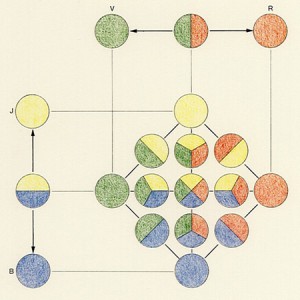In 1983, the Planetary Colour-System, was introduced by frenchman Michel Albert-Vanel, with the intention to organise colour perception multidimensionally.
Albert-Vanel created a so-called Plantetaric Room, in which the colours move like planets in a solar system. The floating planets represent four primary colours, which refer to the psychological primary-colours of Ewald Hering. Albert-Vanel incorporated Herings’ psychological primary colours (Yellow, Red, Green, Blue) into his planetary room. The secondary colours – that connect the primary-colours – are moons and thus orbit the planets.
We almost never see colours isolated but in combination with others, which puts them directly into a context. The planetary system tries with the introduction of new parameters to describe this context in which a colour exists. In order to point out an individual colour, contrast and material are added to the usual parameters of hue, brightness and saturation.
The contrast-parameter unites three new scales (again hue, brightness and saturation) describing a group of colours (the context), to later point out the individual isolated colour.
The scales of the material-parameter describe first if a colour is active (light) or passive (pigment), second if it is transparent or opaque and thirdly: matte or gloss.
With the incorporation of this context a colour is put in, the planetary system involves the natural effects of our colour perception. It considers, that we see colours differently depending on the surrounding it is put in.

